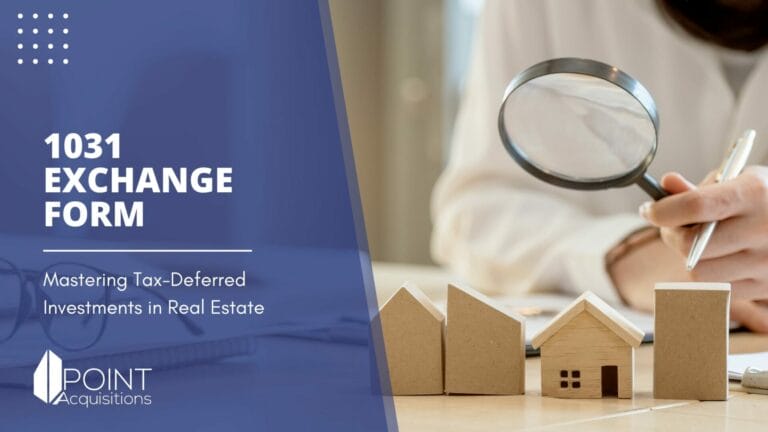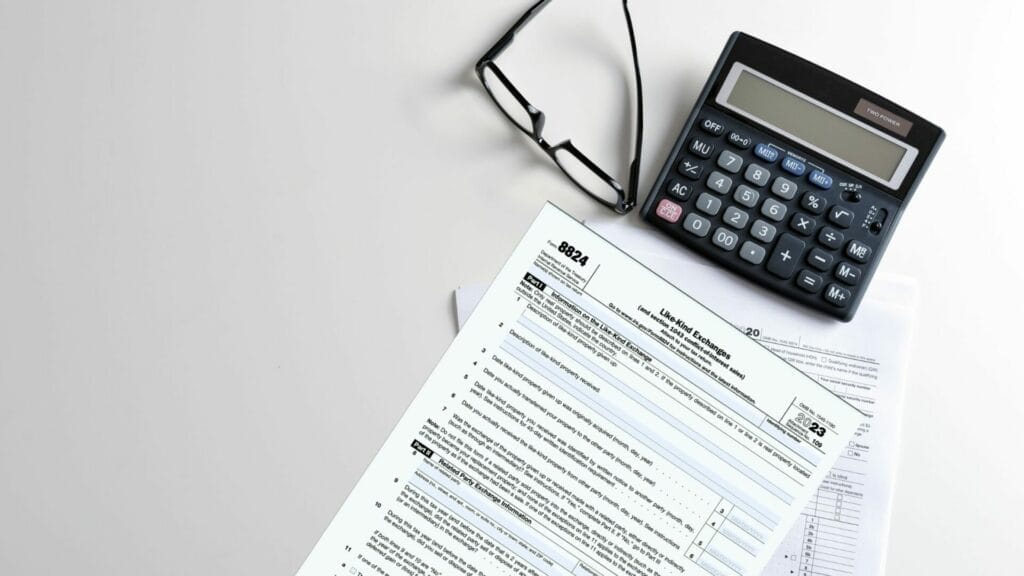
1031 Exchange Form: Your Guide to Tax-Deferred Real Estate Investments
With over 36% of Americans invested in real estate outside of their primary residence, understanding the nuances of a 1031 exchange is more than just a niche interest—it’s a financial imperative for a growing number of investors. Imagine deferring thousands, if not millions, of dollars in capital gains taxes; that’s the power of a well-executed 1031 exchange.
Picture this: You’ve just sold an investment property and are ready to reinvest in a bigger, better option. But without proper guidance, you could miss critical deadlines, misclassify properties, and face hefty tax liabilities—turning your dream of financial growth into a costly nightmare.
Don’t let this be your story. By exploring the details of IRS Form 8824 and the 1031 exchange process, you can manage the complexities with confidence and secure your financial future.
This breakdown strips away the confusion and delivers clear, actionable insights into completing and filing the 1031 exchange form accurately. Expect concise guidance on each part of Form 8824 and key filing deadlines to guarantee your 1031 exchange aligns with IRS regulations.

Table of Contents
Key Takeaways
- A 1031 exchange allows investment property owners to defer capital gains tax by swapping one business or investment property for another, using a qualified intermediary to handle the proceeds and maintain the exchange’s validity.
- IRS Form 8824 is crucial for reporting a 1031 exchange to the IRS; failing to accurately complete and file this form by tax return deadlines can result in the exchange being treated as a taxable sale.
- There are strict timing rules within a 1031 exchange: the 45-day rule for identifying the replacement property and the 180-day rule for acquiring it, with noncompliance resulting in a failed exchange and potential tax liabilities.
1031 Exchange
A 1031 exchange, sanctioned by the Internal Revenue Service (IRS), is a strategic tool rather than a tax dodge. It involves swapping one investment property for another and requires an understanding of specific rules to successfully manage it. Missteps can lead to significant tax liabilities and missed growth opportunities.
At the heart of this process is a qualified intermediary, a neutral third party responsible for holding the funds from the sale of the original property and using them later to acquire the replacement property. This guarantees that the investor doesn’t gain “constructive receipt” of the funds, which would invalidate the 1031 exchange. A qualified intermediary is an important guide in this potentially tricky transaction.
Eligible Properties
Not every property qualifies for a 1031 exchange. The IRS stipulates that the original and the new property must be held for business or investment purposes. This includes a wide range of investment real estate assets, from commercial properties to apartment buildings and even unimproved land, so long as it’s held for productive use in a trade or business or for investment.
Collaborating with an experienced real estate broker is key to identifying suitable replacement properties. Misclassification of properties is a common pitfall in 1031 exchanges, and it can lead to the exchange being considered invalid by the IRS. To avoid this, it’s important to make sure that the replacement property matches the classification of the relinquished property.
See our post on 1031 exchange qualification properties for more information.

IRS Form 8824: Reporting Your 1031 Exchange
The IRS must be informed when you execute a 1031 exchange. Here, IRS Form 8824 becomes relevant. This form serves to report the exchange of business or investment property for property of a like kind, making sure the IRS is aware of the exchange and can verify that it adheres to the necessary regulations for tax deferral.
Failing to report a 1031 exchange on IRS Form 8824 may hinder the IRS’s ability to verify compliance with regulations, potentially leading to the inability to defer capital gains tax. Consequently, this could negate the benefits of the exchange and result in immediate tax liability for the tax year in which the property transfer took place.
Completing Form 8824
While filling out IRS Form 8824 may appear challenging, appropriate guidance can make the process smoother, especially when navigating the tax code. The form consists of three parts:
- Part I: This section requires basic information about the properties involved in the exchange.
- Part II: This section also requires basic information about the properties involved in the exchange.
- Part III: This section calculates the gain or loss, the cash received, and the basis of the replacement property.
A common mistake when completing Form 8824 is providing inaccurate information about the properties or transaction details. To avoid this, it’s essential to use the closing statements from both properties to guarantee you input precise and completely relevant data. Remember to include IRS Form 8824 with your tax return for the year in which the property transfer took place.
Filing Deadlines
In 1031 exchanges, timing plays a key role. The IRS Form 8824 should be filed by your tax return’s due date for the year of the exchange. It’s necessary for you to note that this deadline includes extensions.
Failure to submit Form 8824 by the deadline could have significant repercussions. Your like-kind exchange could be treated as a sales transaction, potentially subjecting it to taxes and possibly reversing your 1031 Exchange. The clock starts ticking when you close on selling your original property.

Timing Rules and Guidelines for 1031 Exchanges
Beyond filing deadlines, stringent timing rules exist for identifying and acquiring replacement properties in a 1031 exchange. These rules are important for maintaining the integrity of the exchange process and making sure that it is not used to avoid taxes unlawfully.
The timing rules for 1031 exchanges are twofold: the 45-day identification rule and the 180-day acquisition rule. These rules provide structure to the exchange process and guarantee a timely transition from the relinquished property to the replacement property.
The 45-Day Identification Rule
The 45-day identification rule is a key stage in the 1031 exchange. It says that you must identify potential replacement properties within 45 days of the sale of the relinquished property. This rule encourages a quick and organized exchange process, limiting the period within which you must choose suitable replacement property.
Non-compliance with the 45-day 1031 exchange identification of replacement property rule can lead to the exchange being unsuccessful, resulting in not deferring capital gains taxes. It’s important to note that this rule has no extensions, even if the final day falls on a weekend or legal holiday. The only exception is if the replacement property is acquired within the 45-day window, in which case no formal identification is required.
The 180-Day Acquisition Rule
Following the identification of your replacement property, the next timing rule to consider is the 180-day acquisition rule. This rule requires that you close on the replacement property within 180 days of selling your original property. The countdown begins on the date of the relinquished property’s sale and includes weekends and holidays.
Failure to comply with this 180-day 1031 exchange acquisition rule could lead to the forfeiture of your 1031 exchange, resulting in a significant tax liability. It’s worth noting that the 180-day period can be extended by submitting an extension for your tax return, providing you with extra time to finalize the acquisition of your replacement property.

Types of 1031 Exchanges: Delayed, Reverse, and More
While most 1031 exchanges are straightforward, there are different types that cater to unique scenarios, each with its own set of rules and procedures. Two such types are delayed exchanges and reverse exchanges, which offer flexibility in handling the order of property transactions.
Understanding the differences between these exchange types is vital, given each type presents its own advantages and challenges. While the basic principle of swapping one investment property for another remains the same, the order of transactions and the timeline can vary significantly, especially when considering mortgage loans.
Delayed Exchange
The most common type of 1031 exchange is the delayed exchange. In this scenario, you go through the following steps:
- Sell your original property.
- The funds from the sale are held by a qualified intermediary.
- Use the funds to acquire the replacement property. This process must be completed within a specified timeframe, usually 180 days.
While a delayed 1031 exchange offers the benefit of time to find a suitable replacement property, it also comes with a risk. If you fail to identify a replacement property within 45 days or close the deal within 180 days, you could end up with a significant tax liability. To avoid this, it’s essential to start the search for a replacement property as soon as possible.
Reverse Exchange
A reverse exchange offers a solution when you find a desirable replacement property before you’ve sold your original property. In a reverse exchange, you acquire the replacement property first, with the sale of the original property happening afterward. This type of exchange provides flexibility but also requires more planning and coordination.
In a reverse 1031 exchange, a third party, called an Exchange Accommodation Titleholder, temporarily holds the title to the replacement property until the original property is sold. This allows you to:
- Secure a promising replacement property without having to rush the sale of your original one
- Take your time to find the right buyer for your original property
- Avoid the risk of losing out on a great replacement property because you haven’t sold your original one yet
However, you still need to meet the standard timing rules for identifying and acquiring properties.

Tax Implications and Strategies
Despite the substantial tax benefits of 1031 exchanges, it’s also important to consider the tax implications. One such implication is depreciation recapture, a tax on the gain realized from the sale of depreciable capital property. Understanding these implications and developing a sound strategy can help you maximize the benefits of a 1031 exchange.
In addition to depreciation recapture, 1031 exchanges also offer estate planning benefits. By deferring tax liabilities until death, heirs can inherit property at its stepped-up market-rate value, potentially reducing or eliminating capital gains taxes.
Depreciation Recapture
Depreciation recapture can come as a surprise to many real estate investors. During the years of owning a property, you may have claimed a depreciation deduction on your tax return, reducing your taxable income. But when you sell the property, the IRS recaptures that depreciation, treating it as taxable income at a maximum rate of 25%.
Fortunately, a 1031 exchange can help minimize depreciation recapture. By rolling over the cost basis of the original property into the new one, you can defer the recapture tax until you eventually sell the replacement property without conducting another 1031 exchange. This allows you to keep more of your money working for you, growing over time.
Estate Planning Benefits
Beyond the immediate tax deferral benefits, a 1031 exchange also offers significant estate planning advantages. By retaining the investment property until death, you can defer capital gains taxes indefinitely. Under current law, heirs inherit the property at its market value at the time of death, also known as a stepped-up basis.
This step-up in basis can reduce or even eliminate capital gains taxes if the heirs decide to sell the property. As a result, the wealth accumulated in the property, including the capital gain, can be passed on to heirs without the burden of a significant tax bill, preserving wealth for future generations.

Common Mistakes and How to Avoid Them
Despite the advantages of 1031 exchanges, many investors come across common issues. These mistakes can range from incorrect property classification to failing to meet timing requirements. Understanding and learning how to avoid these mistakes is crucial to successfully executing a 1031 exchange.
Carefully considering these potential problems and collaborating with seasoned professionals can prevent common errors and optimize the benefits of your 1031 exchange. After all, the goal is to grow your investment portfolio, not to stumble over bureaucratic hurdles.
Incorrect Property Classification
One of the most common mistakes in 1031 exchanges is incorrect property classification. The IRS is clear that only real property held for business or investment purposes qualifies for a 1031 exchange. Misclassifying a property, such as mistakenly identifying a personal residence as an investment property, can lead to the exchange being deemed invalid.
Avoiding this mistake requires careful attention to detail and a clear understanding of what constitutes business-use real estate. Consult a knowledgeable intermediary or tax advisor who can guide you through the process and ensure your properties are correctly classified.
See our post on qualifications and classifications of a 1031 exchange for more information.
Failing to Meet Timing Requirements
Another common mistake in 1031 exchanges is failing to meet the strict timing requirements. Remember, you have 45 days to identify potential replacement properties and 180 days to close on them. Failure to meet these deadlines can lead to the transaction being treated as a taxable event, negating the benefits of the 1031 exchange.
Beginning the exchange process as early as possible is key to guaranteeing compliance with these timing rules. Keep a close eye on the calendar, and consider working with a qualified intermediary who can help keep track of these important deadlines. With careful planning and execution, you can successfully manage the timing requirements of a 1031 exchange.
1031 Exchange Form Summary
A 1031 exchange is a powerful tool for real estate investors seeking to defer capital gains taxes and maximize their investment potential. By swapping one investment property for another, investors can upgrade their portfolio, compound their wealth, and even pass on their assets with minimized tax implications.
However, to successfully execute a 1031 exchange, it’s crucial to understand the rules and regulations, including property eligibility, timing requirements, and tax implications. By avoiding common mistakes and working with experienced professionals, you can harness the power of 1031 exchanges and take your real estate investment strategy to new heights.
Point Acquisitions has plenty more information on 1031 exchange investments. Our team of skilled and knowledgeable experts is waiting for your call.
What form is used for a 1031 exchange?
To report your 1031 exchange, you need to complete Form 8824 and file it with your federal income tax return. This is the required form for a 1031 exchange.
Can you do a 1031 exchange with yourself?
No, you cannot do a 1031 exchange yourself. You must use a qualified intermediary to handle the exchange and hold the proceeds from the sale of your property.
What is the 90% rule for the 1031 exchange?
The 90% rule for a 1031 exchange states that the value of the replacement property must be at least 90% of the sale price of the relinquished property to fully defer capital gains taxes.
What types of properties qualify for a 1031 exchange?
Any real property held for business or investment purposes, such as apartment buildings, commercial properties, and raw land held for productive use, qualifies for a 1031 exchange. Commercial properties and raw land can also be eligible.
About The Author

Jesse Shemesh
Disclaimer
Please note that Point Acquisitions is not a tax expert or tax advisor. The information on our blogs and pages is for general informational purposes only and should not be relied upon as legal, tax, or accounting advice. Any information provided does not constitute professional advice or create an attorney-client or any other professional relationship. We recommend that you consult with your tax advisor or seek professional advice before making any decisions based on the information provided on our blogs and pages. Point Acquisitions is not responsible for any actions taken based on the information provided on our blogs and pages.
1031 Exchange Capital Gains Tax Deferral
According to a 2021 report by the National Real Estate Exchange Services (RES), over 240,000 1031 exchange transactions were completed in the United States, totaling $100 billion. This impressive figure underscores the role of 1031 exchanges in the real estate…
Read More1031 Exchange Benefits
As of Q4 2023, the national vacancy rate for all commercial property types in the United States sat at 9.2%, according to CBRE’s latest insights and research. This represents a slight decrease compared to the previous quarter and suggests a…
Read More1031 Exchange Legal Considerations: A Must-Read Guide
You’re in the right place if you’re considering a 1031 exchange for your commercial real estate investments. Whether you’re a seasoned investor or just dipping your toes into the market, understanding the legal landscape of 1031 exchanges is key to…
Read More

